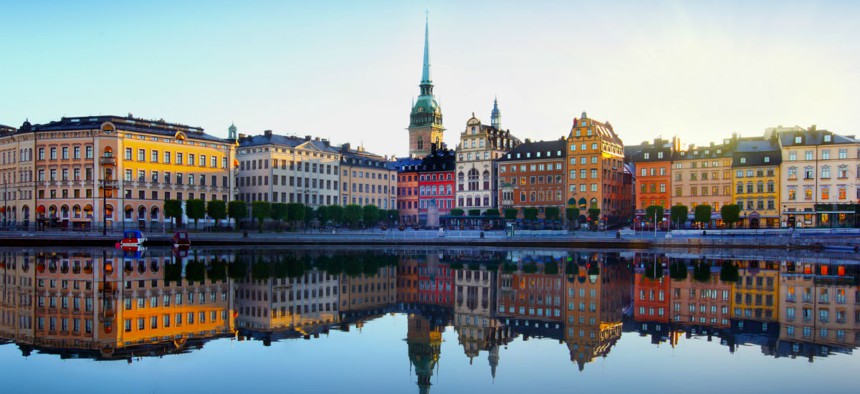What the U.S. Can Learn from Protest and Political Organizing in Nordic Countries
Scholar argues that Americans can adapt the Nordic model to reduce the wealth gap and improve quality of life.
Liberals in the United States wistfully regard Scandinavia as a kind of social utopia, while conservatives denounce it as a socialist state where government overreach is ubiquitous. Yet across the political spectrum, Americans believe it would be impossible to adopt the Nordic model.
That’s the starting point for Viking Economics: How the Scandinavians Got it Right—and How We Can, Too, a new book from George Lakey, a former Eugene M. Lang visiting professor for issues of social change at Swarthmore College. Lakey, however, rejects that premise, arguing instead that Americans can adapt the Nordic model to fit the United States, reducing the wealth gap and improving the quality of life for all Americans as a result.
There are limitations to attempts to compare the United States with Norway, Denmark, Sweden, and Iceland—the four countries with Viking ancestry that the book focuses on. The United States is far larger than each of those countries, to say nothing of cultural, demographic and political differences. Life in Nordic countries is not always idyllic, either. While Nordic nations consistently rank among countries with the highest quality of life, they are not immune to anti-immigrant and authoritarian political impulses.
Lakey acknowledges the challenge of comparison and notes that the Nordic way is not a panacea. Nevertheless, he believes that Americans have much to learn from Norway, Denmark, Sweden, and Iceland. In particular, he argues that Americans can draw lessons from the success that Nordic citizens have had in bringing about economic and social change by making demands on their government through political protest. A transcript of our conversation, edited for clarity and length, appears below.
Foran: What myths do you think Americans hold about the Nordic countries?
Lakey: A lot of people mistakenly believe that the countries with Viking ancestry—Norway, Denmark, Sweden, and Iceland—have always had the high standard of living that they do today. That’s not the case, and people don’t realize what it took to create the kind of society we see today in each of these countries.
A century ago, the economic elite ran each of those countries. There was the pretense of democracy, but it was always the decisions of economic elites that carried the day. There was poverty and a lack of empowerment of the people. The change that came about in the Nordic countries so that they eventually moved to an economic model where there was less of a wealth gap, and better quality of life, came about after everyday people made demands on their governments to change.
The 1 percent may occupy state power, but when the majority of the country stands up in opposition to the 1 percent, they can make the country ungovernable. That’s what happened in Nordic countries, and that’s what opened up the political space in which they could build an economic model that far outperforms the economic model of the United States.
Foran: Do you think it’s detrimental from an American perspective to be unaware of that history?
Lakey: Yes, absolutely. If we think that the Nordic model has always existed in the way we think of it today, then it starts to seem like something that’s totally unique to those countries that can’t be replicated in any way. That belief can become immobilizing.
Foran: You make a distinction between the power of voting and the power of protest and mass mobilization of people. Can you talk about the distinction?
Lakey: In the Nordic countries, people first created popular movements that used direct-action tactics like strikes, boycotts, and demonstrations. They also built movement infrastructure, like co-ops and study circles. As these movements gained momentum, they led to the creation of political parties that were controlled by the movements and represented the movements in parliament. In that way, politicians were accountable to the people.
That’s entirely different from what we have in the U.S. with the Democratic Party, for example, where the party is not really accountable to anyone except the economic elite. Today, the U.S. also has low voter participation compared with the Nordics. The path they took—building powerful grassroots movements that then control the politicians who represent them, might help us achieve the degree of democracy that they enjoy.
Foran: Do you think there are culturally rooted ideals about individualism as opposed to collectivism that are different in the U.S. and Nordic countries that make it difficult for Americans to organize political movements?
Lakey: Well, each culture brings assets and liabilities to the challenge of creating a real democracy, and that means that movement building in the U.S. will look different sometimes from what it looks like in Nordic countries.
One advantage that people have in the Nordic countries—in terms of organizing around demands—is they speak the language of interests without apology. They understand that individuals and groups have interests and there are circumstances where it makes sense for people to work together toward a common goal, because it’s in their collective interest to do so.
On the other hand, the ability of Nordic individuals to join together to pursue their interests doesn’t diminish their individuality. The transparency of the process promotes the common good, since they understand that without the enhancement of the common good, individuals lose.
Foran: What about other limitations in comparing the United States and Nordic countries. For example, the U.S. has a history of racial disparity and discrimination. How does that make comparisons difficult?
Lakey: Racism is of course a reality in the Nordic countries—but it’s not the same as the U.S. legacy of having had a substantial part of your country holding slaves and having enslavement as an institution, legal and real. That continues to be an enormous burden for the United States and makes it difficult to forge the kind of national coalitions and broad movements that are necessary to set things right.
On the other hand, our vision for what we can achieve decades down the road can benefit from the inheritance of racial diversity we have in our country. There are any number of Nordic people who envy the kind of richness of cultural and racial diversity that we have here in the United States.
Currently, we are in a period where we are seeing a new civil-rights movement in the United States. Black Lives Matter is one expression of that. The movement we see now is far more likely to approach economic justice and racial justice as intertwined, so that bodes well and is one example of movement building in the U.S.
Foran: I also want to talk about immigration. In the U.S. presidential election, immigration has been an extremely contentious issue, particularly on the Republican side. There has been anti-immigrant backlash in Nordic countries as well. What do you think we can take away from that?
Lakey: There has certainly been a Nordic struggle with xenophobia. The reality is that wherever there is a white settlement in the world, there’s racism, and wherever nationalism exists, there will be some xenophobia. In recent decades, the four countries have opened to more immigration—Sweden has accepted the highest number per capita of refugees from the Middle East of any country in Europe.
This naturally generates backlash, including Islamophobia. The advantage the Nordics have over the U.S., however, is that their economic model reduces the insecurity that fuels pushback and assures the newcomers maximum possible opportunity to integrate into the country and add to the talents and skills that strengthen already robust economies. Equality isn’t just an ideal. It is a pragmatic economic advantage.
Foran: Are there examples of mistakes that Nordic countries have made that could be as instructive for the U.S. as their successes?
Lakey: Well, Iceland’s 2008 economic collapse is an instructive example. Iceland became a basket case after the financial crisis that arrived in the wake of deregulation. Some people regarded it as a failed state. After the collapse, people took to the streets in protest, and backed by a people’s movement, Icelanders brought down the previous government that had been careless and installed a new government. In the wake of the crisis, Iceland seized major banks rather than bailing them out, and the government ultimately put the country on a path to economic recovery that was far quicker than what we have seen in the U.S.
Foran: There has been a lot of talk about political movements and protest in the context of the Bernie Sanders presidential campaign. What do you think is the most effective way to channel the energy inspired by that campaign so it doesn’t dissipate? What do you think would squander that enthusiasm?
Lakey: The best thing for Sanders supporters to do would be to focus their energy on direct-action campaigns aimed at achieving specific policy goals. So, for example, if Sanders supporters took the goal of free higher education and turned that into a direct-action national campaign that protesters were willing to go to jail for, that would be a more effective way of achieving that goal than even getting Sanders elected to the presidency. Sanders in the Oval Office wouldn’t be able to get anything done with the current Congress, whereas with a direct-action pressure campaign, there is a better chance of actually getting something like free higher education or Medicare for all accomplished.
The biggest mistake that supporters of Bernie Sanders could make would be if they were to say, “Well let’s go back to the Democratic Party and contest for power within the party.” That’s a losing proposition. The party cannot be changed from within, it needs to be held accountable from the outside.
Foran: What about the idea that to achieve change, you need to exert pressure from inside the political structure as well as from the outside. Don’t you think that both are needed?
Lakey: When the Democratic Party sees that an externally driven campaign is growing and growing, eventually people within the party will change their policy to accommodate that. That’s what happened with the civil-rights movement. The federal government couldn’t have cared less about the civil-rights movement until the movement grew in power and influence to the point where, to maintain their own credibility, the Democratic Party had to modify its position on civil rights.
We don’t need to attempt to organize Democrats to play the inside game or attempt to become part of that inside game. Elected officials will do that on their own so as not to alienate their base, so long as there is enough pressure from the outside. The question is where the control and the initiative come from. If the control is outside the Democratic Party with an independent initiative, then it will be in the interest of the Democrats to change their position to accommodate that as long as the pressure is strong enough.
Foran: What about Sanders himself? How do you think he can be effective in achieving the goals he has outlined during his campaign?
Lakey: The best way for him to increase his influence would be to choose an issue that he has advocated for in his campaign, and work to advocate for that, and support the grassroots organizing that springs up to work toward the same goal. He won’t be able to achieve his goals—for example, something like Medicare for all—as a senator by staying within the usual legislative means. I also don’t think he should try to be the leader of any grassroots movement, but he can still play an important role. As a senator, he has a highly visible platform that he can use to broadcast and amplify grassroots agitation in support of policy change.








